-
Countries
-
Data and Analysis
-
Special Focus
-
Crisis Responses
Flow Monitoring
Domain host
migration.iom.int
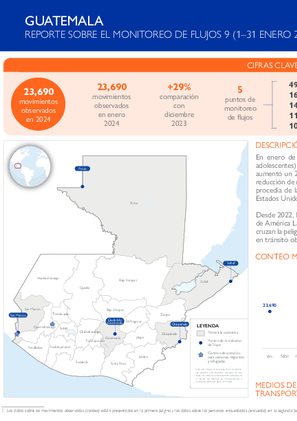
Contact
iomguatemala@iom.int
Language
English
Location
Guatemala
Period Covered
Jan 01 2024
Jan 31 2024
Activity
- Flow Monitoring
En enero de 2024 se observaron 23,690 movimientos en Guatemala (16% niños, niñas y adolescentes) y 564 personas fueron encuestadas.1 El número de movimientos observados aumentó un 29 por ciento desde diciembre de 2023 (18,390) debido a la tendencia habitual de reducción de movimientos por las festividades de fin de año. Más de la mitad de los movimientos procedía de la República Bolivariana de Venezuela (53%). El principal destino previsto fue los Estados Unidos de América (87%).
Desde 2022, los flujos de migrantes en tránsito se incrementaron significativamente en la región de América Latina y el Caribe, observando cantidades nunca antes registradas de personas que cruzan la peligrosa selva del Parque Nacional del Darién desde Colombia hacia Panamá. Los flujos en tránsito observados en Guatemala han reflejado dichas tendencias migratorias regionales.

Contact
DTM Libya, DTMLibya@iom.int
Language
English
Location
Libya
Period Covered
Oct 01 2023
Dec 31 2023
Activity
- Flow Monitoring
- Mobility Tracking
- Baseline Assessment
This infographic presents the key findings of Round 50 of the mobility tracking and flow monitoring components of the Displacement Tracking Matrix (DTM) programme in Libya.
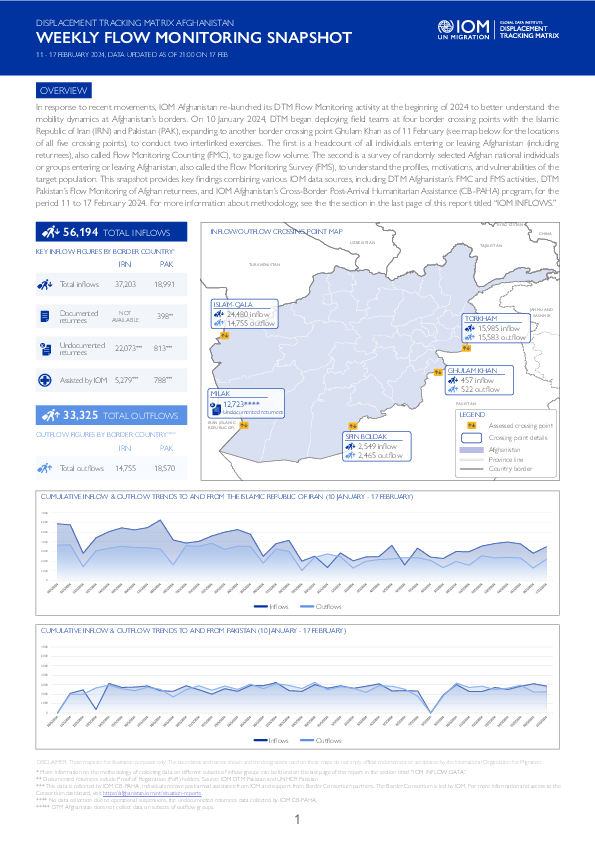
Contact
DTMAfghanistan@iom.int
Language
English
Location
Afghanistan
Period Covered
Feb 11 2024
Feb 17 2024
Activity
- Survey
- Flow Monitoring Survey
- Flow Monitoring
In response to recent movements, IOM Afghanistan re-launched its DTM Flow Monitoring activity at the beginning of 2024 to better understand the mobility dynamics at Afghanistan’s borders. On 10 January 2024, DTM began deploying field teams at four border crossing points with the Islamic Republic of Iran (IRN) and Pakistan (PAK), expanding to another border crossing point Ghulam Khan as of 11 February (see map below for the locations of all five crossing points), to conduct two interlinked exercises. The first is a headcount of all individuals entering or leaving Afghanistan (including returnees), also called Flow Monitoring Counting (FMC), to gauge flow volume. The second is a survey of randomly selected Afghan national individuals or groups entering or leaving Afghanistan, also called the Flow Monitoring Survey (FMS), to understand the profiles, motivations, and vulnerabilities of the target population. This snapshot provides key findings combining various IOM data sources, including DTM Afghanistan’s FMC and FMS activities, DTM Pakistan’s Flow Monitoring of Afghan returnees, and IOM Afghanistan’s Cross-Border Post-Arrival Humanitarian Assistance (CB-PAHA) program, for the period 11 to 17 February 2024. For more information about methodology, see the the section in the last page of this report titled “IOM INFLOWS.”

Contact
DTM Libya, DTMLibya@iom.int
Language
English
Location
Libya
Period Covered
Oct 01 2023
Dec 30 2023
Activity
- Flow Monitoring
- Migrants presence
- Mobility Tracking
- Baseline Assessment
IOM Libya’s Displacement Tracking Matrix (DTM) programme identified a total of 706,509 migrants from 45 nationalities in the 100 Libyan municipalities during round 50 of data collection (October - December 2023). The number of migrants in Libya increased slightly compared to the previous round of data collection (from 697,532 migrants, round 49 to 706,509 migrants, round 50).
Despite improvement in the overall migrant unemployment rate, around half of female migrants continue to be unemployed and actively seeking work (49%) — more than three times the percentage of males (14%). At the same time, financial issues continue to be the main difficulties faced by the majority of migrants, regardless of sex or age. DTM Libya data further shows that economic constraints are the main obstacle impeding migrants’ access to essential services including healthcare, clean drinking water and education for their children.
Contact
dtmlibya@iom.int
Location
Libya
Activity
- Mobility Tracking
- Baseline Assessment
Period Covered
Oct 01 2023 -Dec 31 2023
Libya Migrants baseline assessment
Population Groups
Migrants Present
Survey Methodology
Unit of Analysis Or Observation
Admin Area 3
Admin Area 4
Type of Survey or Assessment
Key Informant
Keywords
Geographical Scope Full Coverage
Administrative boundaries with available data
The current dataset covers the following administrative boundaries

Contact
NPM Bangladesh, npmbangladesh@iom.int
Language
English
Location
Bangladesh
Snapshot Date
Jan 15 2024
Activity
- Other
The inflow of remittances is one of the main driving forces in Bangladesh’s economic growth and development (IOM, 2021b). Remittances support the economy by increasing foreign exchange reserves and national savings and reducing poverty levels (Chowdhury and Chakraborty, 2021). During the COVID-19 global pandemic in 2020, there was decrease in overseas Bangladeshi migrant workers and the inflow of remittances to the country was initially predicted to decline significantly in 2020 (Asia Development Bank, 2020; World Bank, 2020a). However, contrary to all negative forecasts, recorded remittance inflows to Bangladesh remained resilient during 2020 (IOM, 2021a; IOM, 2022). Nevertheless, even though the emigration of migrants increased again in 2021 and in 2022, the inflow of remittances to Bangladesh started to decline. The World Bank’s prognosis for 2023 expects a further drop in remittances to South Asian countries (World Bank, 2023). This snapshot aims to provide an overview of the remittance situation in Bangladesh between 2019 and 2022.
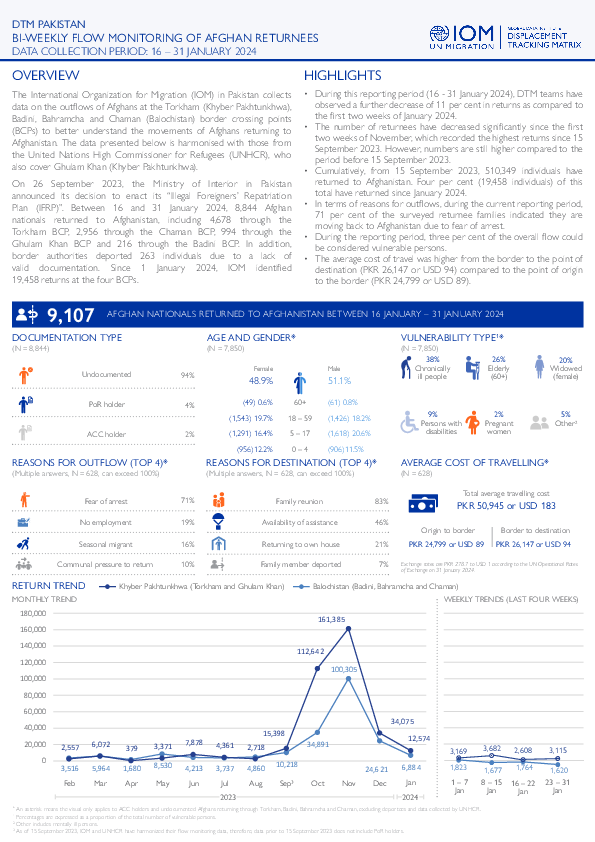
Contact
DTMPakistan@iom.int
Language
English
Location
Pakistan
Period Covered
Jan 16 2024
Jan 31 2024
Activity
- Flow Monitoring
On 26 September 2023, the Ministry of Interior in Pakistan announced its decision to enact its “Illegal Foreigners’ Repatriation Plan (IFRP)”. Between 16 and 31 January 2024, 8,844 Afghan nationals returned to Afghanistan, including 4,678 through the Torkham BCP, 2,956 through the Chaman BCP, 994 through the Ghulam Khan BCP and 216 through the Badini BCP. In addition, border authorities deported 263 individuals due to a lack of valid documentation. Since 1 January 2024, IOM identified 19,458 returns at the four BCPs.
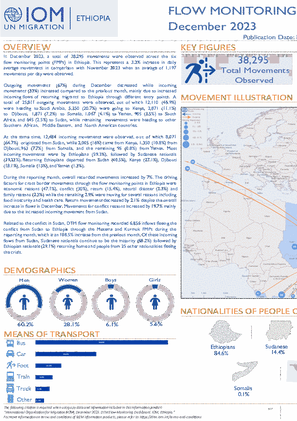
Contact
DTM Ethiopia, DTMEthiopia@iom.int
Language
English
Location
Ethiopia
Period Covered
Dec 01 2023
Dec 31 2023
Activity
- Flow Monitoring
In December 2023, a total of 38,295 movements were observed across the six flow monitoring points (FMPs) in Ethiopia. This represents a 3.2% increase in daily average movements in comparison with November 2023 when an average of 1,197 movements per day were observed.
Outgoing movements (67%) during December decreased while incoming movements (33%) increased compared to the previous month, mainly due to increased incoming flows of returning migrants to Ethiopia through different entry points. A total of 25,811 outgoing movements were observed, out of which 12,110 (46.9%) were heading to Saudi Arabia, 5,350 (20.7%) were going to Kenya, 2,871 (11.1%) to Djibouti, 1,871 (7.2%) to Somalia, 1,067 (4.1%) to Yemen, 905 (3.5%) to South Africa, and 645 (2.5%) to Sudan, while remaining movements were heading to other Southern African, Middle Eastern, and North American countries.
At the same time, 12,484 incoming movements were observed, out of which 8,071 (64.7%) originated from Sudan, while 2,005 (16%) came from Kenya, 1,350 (10.8%) from Djibouti, 963 (7.7%) from Somalia, and the remaining 95 (0.8%) from Yemen. Most incoming movements were by Ethiopians (59.3%), followed by Sudanese nationals (39.22%). Returning Ethiopians departed from Sudan (40.5%), Kenya (27.1%), Djibouti (18.1%), Somalia (13%), and Yemen (1.3%).
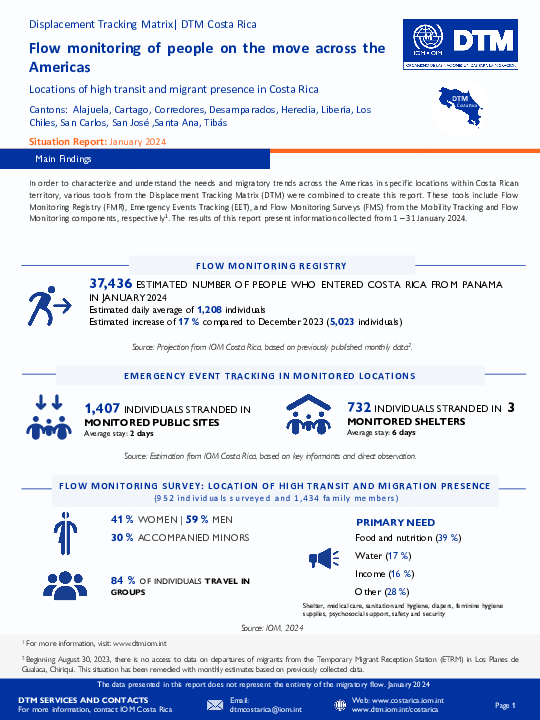
Contact
DTMCostaRica@iom.int
Language
English
Location
Costa Rica
Period Covered
Jan 01 2024
Jan 30 2024
Activity
- Flow Monitoring
- Mobility Tracking
- Event Tracking
Cantons: Alajuela, Cartago, Corredores, Desamparados, Heredia, Liberia, Los Chiles, San Carlos, San José, Santa Ana y Tibás
Costa Rica, like the other countries in the Central American region, has been characterized as a migratory corridor for people who transit by land from the south to the north of America and whose destination is the countries in the north of the continent. This flow on the move through the Americas is mainly made up of people from the Bolivarian Republic of Venezuela, Cuba, Haiti, Ecuador, as well as people from other countries in South America, Africa and Asia.
According to estimations from IOM Costa Rica, during December 37,436 people entered the country, an approximate average of 1,208 people per day and estimating a increase of 30% compared to December 2023. In addition, 1,407 people stranded in the monitored shelters were identified and 732 people stranded in the public places visited.

Contact
Angélica Madrigal amadrigal@iom.int
Language
English
Location
Costa Rica
Period Covered
Jan 01 2024
Jan 30 2024
Activity
- Survey
- Registration
- Flow Monitoring
Cantones: Alajuela, Cartago, Corredores, Desamparados, Heredia, Liberia, Los Chiles, San Carlos, San José, Santa Ana y Tibás
Costa Rica, al igual que los demás países de la región centroamericana, se ha caracterizado por ser un corredor migratorio para personas que transitan de manera terrestre desde el sur hasta el norte de América y que tienen como destino los países del norte del continente. Este flujo en situación de movilidad por las Américas se encuentra compuesto principalmente por personas de la República Bolivariana de Venezuela, Cuba, Haití, Ecuador, así como personas provenientes de otros países de Suramérica, África y Asia.
Según estimaciones de la OIM Costa Rica, durante enero ingresaron al país 37.436 personas, un promedio aproximado de 1.208 personas por día y estimando un aumento de un 30% con respecto a diciembre de 2023. Además, se identificaron 1.407 personas varadas en los albergues monitoreados y 732 personas varadas en los sitios públicos visitados.
Pagination
- Previous page
- Page 25
- Next page